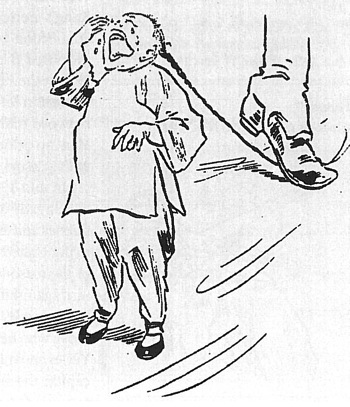
The Manchu hairstyle was forcefully introduced to Han Chinese by Nurhaci in the early 17th century. Some, such as Zhang Xun, still did as a tradition, but most of them abandoned it after the last Emperor of China Puyi cut his queue in 1922. In the early 1910s, after the fall of the Qing dynasty, the Chinese no longer had to wear it. The hairstyle was compulsory on all males and the penalty for not having it was execution as it was considered treason. The hairstyle consisted of the hair on the front of the head being shaved off above the temples every ten days and the rest of the hair braided into a long ponytail. The queue was a specific male hairstyle worn by the Manchus from central Manchuria and later imposed on the Han Chinese during the Qing dynasty. It was worn traditionally by certain Native American groups and the Manchu of Manchuria.

Please contact us for special requests, specific items that you might have in mind and other such requirements that we might be able to assist you with.The queue or cue is a hairstyle in which the hair is worn long and gathered up into a ponytail. Custom fitting appointments are available in person and virtually, for those who require them and where applicable please contact us as to arrange such an appointment. All items may be subject to a delay and currently each item will require one to two weeks to produce and ship from our workshop, unless otherwise noted.Īll bespoke modern and historical clothing and items are dependent upon the measurements provided by you, the buyer and we cannot take responsibility for mishitting items as a result of improperly provided measurements and associated requirements. This item is made to order and will be ready in less than two to three weeks (usually sooner) from the order date.Īll items are sold as is and are produced on a per order basis each work is a custom piece and reproduced (where applicable) by hand and using period materials as close as possible to the original materials used in the 17th, 18th and 19th centuries. This item is available in several colours of hair, as well as ribbon, at additional cost, owing to the cost of lighter hair colours. The securing ribbon around the head can also be removed to attach the item to a cap, or reintroduced, as needed, to wear once again upon the head. Further, this item may also be used with one of our silk hair/wig bags. While being the most appropriate style of hair for an infantryman, this piece is also highly appropriate for civilian use, as being initially 16" long, this clubbed queue can be restyled into numerous styles, such as braided, or adapted for Grenadier usage and secured to their bearskin. This specific queue is also finished with period correct and army appropriate pomatum, using a lavender scent. Being both a practical and attractive style of hair management, this was a favoured method of King George and quickly employed throughout the Army. References to such a style of hair can be found in most orderly books, as well as period military guides, such as those of Cuthbertson. Being clubbed (folded) into shape and secured with a black pure silk ribbon, in accordance with the Regulations of the Summer of 1776, as well as the general practice of both Line, Grenadier and Light Company infantry and Guards Regiments throughout the war.

QUEUE HAIR FULL
This item has been produced owing to the large number of requests that we have received for a proper, full length human hair queue that meets the standards of the British Army, during the era of the American Revolution.

We are excited to offer you this real human hair, blonde, reproduction 17th and 18th century clubbed false queue! The original length of this hair, unclubbed is a full 16" long, quite a length and plenty to work with for many other period styles.


 0 kommentar(er)
0 kommentar(er)
